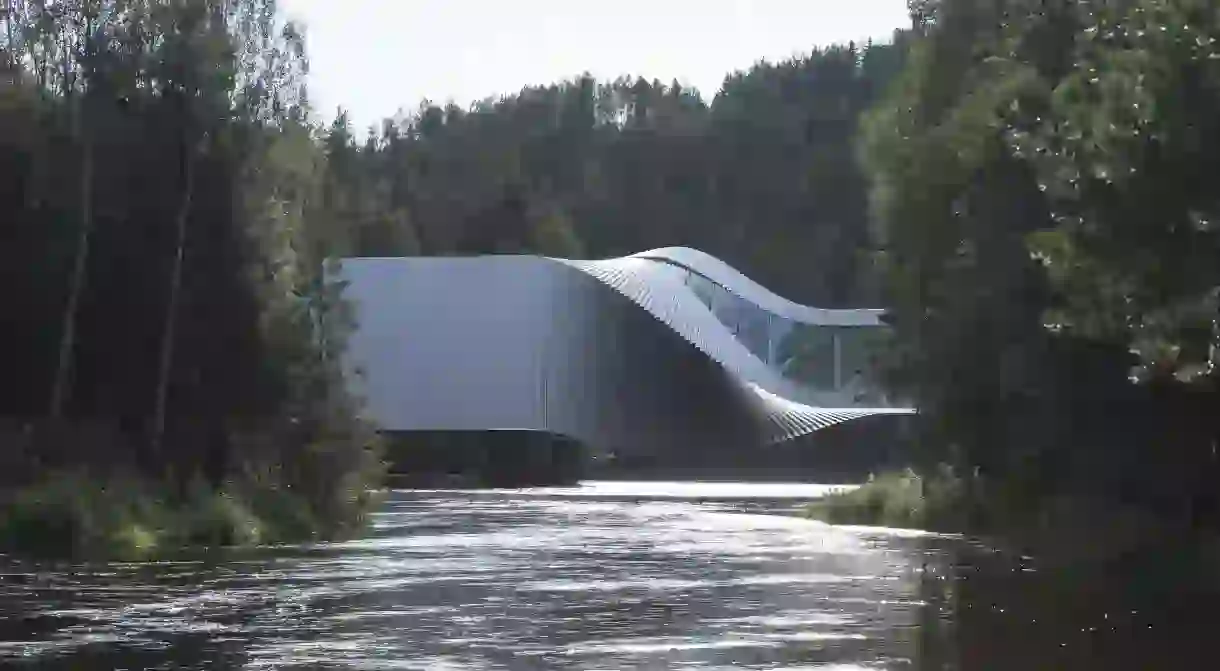An Art Gallery With a Twist in the Norwegian Forest

Is it a bridge, an art gallery, a building or a sculpture? The correct answer: all of the above. New gallery The Twist is the latest in a series of exciting architectural projects in Norway, and lets you experience art and nature in a truly immersive way.
Oslo was founded almost a thousand years ago, but there’s nothing old-fashioned about the Norwegian capital, its striking skyline looming over the blue waters of the Oslofjord. In the past couple of decades, the city has emerged as a visionary place for contemporary architecture and design. Snøhetta’s sculptural, snow-white Opera House and cantilevered Bærum Cultural Centre, A-Lab’s stacked horizontal office blocks for Equinor (previously Statoil), the Barcode high-rises by multiple architecture firms and Renzo Piano’s sail-shaped Astrup Fearnley art gallery are just some of the high-profile new buildings that have put Oslo on the map for architecture fans. In 2019, a new contender for most exciting building in Norway was added to the list: art gallery The Twist, designed for the Kistefos sculpture park and museum in the forest about an hour outside of the seaside city.

The Twist is the inaugural project in Norway of Danish architecture firm Bjarke Ingels Group (BIG) and attracted attention right from when it was first announced. It’s easy to understand why when you see it. The ‘inhabitable bridge’ (the architects mention Florence’s Ponte Vecchio as a reference) gets its name from the arresting 90-degree twist in its middle that makes the structure look ever so slightly unreal, like a computer-generated vision come to life. The graceful edifice consists of two contrasting spaces conjoined: enter it from one side and you’re met by a high-ceilinged room lit by artificial light; if you choose the entrance on the other shore, however, you’ll experience a panoramic view of the river in a compact space drenched with natural light.

Kistefos’s founder, Christen Sveeas, has a vast art collection and may show some of it at The Twist, but the gallery will mainly host visiting contemporary exhibitions. Sveeas hopes the attention generated by its unusual design will increase Kistefos’s status. “I think collectors will think, ‘I’d like to lend to that museum, it’s a cool place to go,’” he says. Now that the museum is ready, visitors can wander around the park’s sculpture collection – featuring works from artists such as Olafur Eliasson, Jeppe Hein and Yayoi Kusama – and cross the river through The Twist, experiencing the artworks and the newly walkable circuit through the park.

Even the bathrooms in the new gallery are an unmissable architectural feature. Located below the main body of the building, where the bridge hits the river, the space gives you a perfect view of the undulating belly of the bridge. Architect Bjarke Ingels says this was very much intentional. “In architecture school, they teach you that whenever you go and see a new building, you have to go to the toilet. You can see if it’s true architecture if the intention remains with you all the way to the most private moments.”
The striking exterior of The Twist is made from anodised aluminium panels, which gives the building a functional, industrial feel not usually associated with the lofty realms of art gallery design; though galleries in post-industrial spaces are common, it’s rarer for new commissions to adhere deliberately to that aesthetic. Inside, the entire bright, white-painted interior consists of straight fir slats, a nod to the surrounding forest and Kistefos’s past as a wood pulp mill. The immersive design means that as you walk on the floor, it eventually becomes the wall, the planes blending together. When walking through the centre of the gallery, you’re inside the twist itself, which Ingels describes as creating “a third room: a sculptural, challenging space on the inside, and a sculptural form on the outside that transforms the entire museum into a sculpture in its own right”. For the museum’s inaugural exhibition, artworks were even hung on the sloping walls – a daring curatorial choice that won’t be possible with all pieces, but adds to The Twist’s vibe as a gallery that dares to be different.

The Twist is just the latest addition to Norway’s vibrant art scene, as the country continues to invest in culture. Two major museums open in Norway in 2020 – the new National Museum, slated to be the largest art museum in the Nordic region, and the new Munch Museum. Located at the site of the former Vestbanen station, Nasjonalmuseet (the National Museum) is a true leviathan, with 90 spacious exhibition halls designed by Kleihues + Schuwerk. The museum’s top floor will be an alabaster hall that functions as a gigantic light box where artists can play with the space and even create works in situ. The Munch Museum is equally impressive. One of the world’s largest museums dedicated to a single artist, the 13-floor space by estudio Herreros is made in environmentally friendly, recyclable concrete and steel. Like so many of the other innovative buildings that have opened in Oslo, The Munch Museum and National Museum are located by the waterfront, ensuring that the Oslo skyline continues to dazzle.














